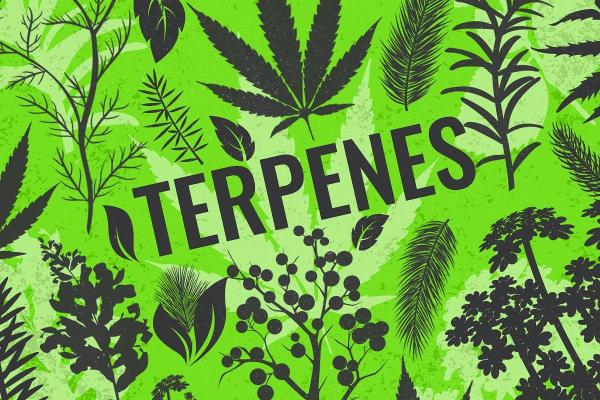Medical Marijuana
The Tasty World of Terpenes
You know the taste when you light up a fresh spliff of Blueberry? Or the pungent skunk of a decent Kush? Or the piney-ness of your favourite strain that shines through even in a concentrate, like shatter?
We owe all of these magnificent tastes and smells that characterize our strains—from the boldest to the base—to terpenes.
The culture of cannabis is full of jargon, but “terpene” may be a new one for many people. The reason for their relative obscurity is the fact that terpenes work behind the scenes. Terpenes aren’t necessarily something that be gauged by sight—they are chemical compounds and they are single-handedly responsible for many of the things that we love most about cannabis.
THE SCIENCE
Imagine termites teeming on and through their mound in an arid grassland. The chirping and buzzing of a thousand insects fills the air, and under it all, the finite cracking and bending of grass as a spider picks its way toward them. The spider is far more fearsome than the termites—as large as a dozen individual termites, in fact. She spots the busy worker that will be her dinner. She steps closer, and closer, and—the termites notice her approach and fire a toxic glue-like substance from a special gland in their heads. The barrage strikes the spider multiple times, including on the legs, where the substance quickly sets and binds the spider to the ground.
This display is one of the more exciting applications of terpenes in nature—the gluey substance that incapacitated and will eventually kill the spider is a specialized form of terpene produced by a particular subfamily of termite.
Aside from being weaponized by termites, terpenes can be found throughout the natural world, fulfilling a variety of tasks. In so many words, terpenes are a diverse family of aromatic chemical compounds that are most often produced by plants in order to attract pollinators, or as a defense mechanism. They are generally characterized by strong odour and a sticky, resinous constitution. Examples of terpenes in the natural world include those in the resin of coniferous trees (pinene), limonene (responsible for the “citrus” quality of citrus fruits), linalool (that sweet lavender smell), and myrcene, which gives hoppy beer its delectable kick.
IN CANNABIS
In the cannabis plant, terpenes are produced and stored in the trichomes (those hairy glands that protrude from decent bud and let you know that you got the good stuff). The diverse smells and tastes of different strains of cannabis can be explained by the surprising abundance of terpenes that are produced by the cannabis plant: over one hundred and counting! Interestingly, the terpenes share their trichomatic homes with another favourite of cannabis users: the cannabinoids.
Considering that terpenes are the fundamental ingredient in essential oils from medicinal plants, it’s plain to see why they’re an important consideration for cannabis. Not only do they confer the taste and character that are so appreciated by the cannabis connoisseur, but research is finding more and more that terpenes may have a very real part to play in the medicinal effects of strains.
Studies dating as far back as the 1980s have identified the ability of certain terpenes to alter the effects of cannabinoids. Namely, they can inhibit or augment the primary effects of cannabis by binding endocannabinoid receptors in the brain and imitating compounds naturally produced in the body. If paired correctly, the anti-inflammatory properties of pinene could supplement those of CBD to make a particular strain an anti-inflammatory powerhouse. Another useful pairing would be a strain that includes humulene to counter the appetite-increasing effects of THC. Basically, terpenes can be used in conjunction with cannabinoids that have similar effects in order to exacerbate those effects, or terpenes could be included which actually counter the effects of cannabinoids, or focus on other matters, ultimately diluting the effects.
Once upon a time, all that serious cannabis users cared about was whether a strain was sativa or indica. Nowadays, with greater attention to all of the properties of a plant, terpenes are the new hot topic, and cannabis connoisseurs are beginning to view them with a more careful eye—just as a sommelier will look for notes in fine wine.
EXTRACTION
Terpene profiles are what separate quality extractions from the run-of-the-mill. Producers are taking great care to preserve these only-recently appreciated properties that make each strain so unique. At a certain level of quality, the handling of cannabis becomes almost as important as the cultivation, as improper handling can quickly dislodge and lose these delicate, precious trichomes, along with their flavour and cannabinoid content. The same is true for extraction.
When creating extractions like shatter and distillate, producers must treat terpenes with methods that are half art, half science. Terpenes are highly sensitive to heat, and can easily be destroyed or altered at the wrong temperatures. Moreover, certain terpenes are activated at certain temperatures, while others may not be. Extraction is therefore a very delicate process.
For example, in supercritical CO2 extraction, extracting terpenes is the first step. The desired terpenes are extracted at subcritical temperatures (i.e. below cannabinoid extraction temperature) from fresh plants and then the extracted oil is reintroduced and blended with the extracted cannabinoids. A similar strategy is undertaken in distillation, a method which creates one of the purest products imaginable. This extraction method separates compounds by their boiling points. Again, terpenes are extracted first, and at lower temperatures and pressures than cannabinoids in order to preserve their integrity, and reintroduced into the final product.
The care that technicians and producers take with extracting terpenes truly speaks to their importance in modern cannabis.
FINAL “NOTES”
Terpenes add the fine notes to cannabis, and they even add their own effects to plants that are already medicinal powerhouses. As more research is performed, particularly in the medical field, it is inevitable that the industry as a whole will continue to discover their importance to the overall cannabis experience, and their healing potential. Who knows, we may even see a movement in the cannabis community that gives terpenes greater attention than the cannabinoids themselves, at least perhaps for those who don’t appreciate the psychoactive high brought on by many strains. In any case, terpenes are critical components of every cannabis strain, and we are excited to see what new discoveries lay ahead!


